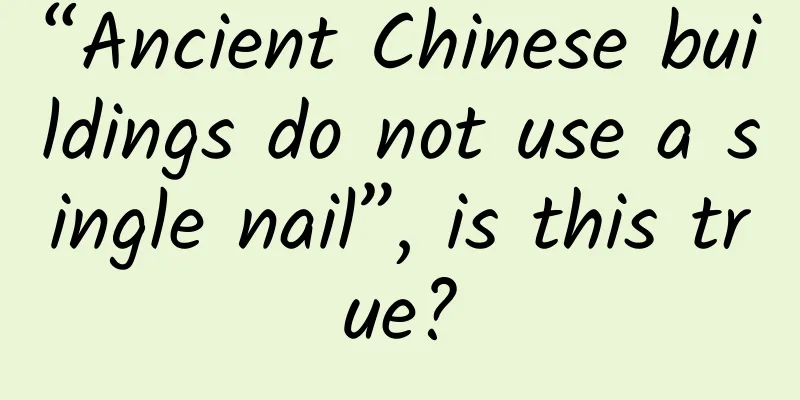“Ancient Chinese buildings do not use a single nail”, is this true?

|
When visiting ancient buildings, you will often hear a propaganda slogan: "China's wooden structure buildings do not use a single nail, and rely entirely on mortise and tenon structures." Is this true? 01 What is mortise and tenon structure? The most common structural method in woodwork is the mortise and tenon joint , which is widely used in Chinese architecture, furniture and other wooden components. The different parts are connected into one by splicing and interlocking the convex and concave parts. The convex part is called the tenon (also called the tenon head), and the concave part is called the mortise (also called the mortise socket, mortise mouth). Copyright image, no permission to reprint In the 1970s, we saw the use of mortise and tenon joints on the remains of stilt houses discovered at the Hemudu cultural site (about 7,000 years ago, the site is distributed in the area south of the lower reaches of the Yangtze River) . Square tenons, round tenons, dovetail tenons, tongue-and-groove tenons, etc., became the earliest traceable examples of mortise and tenon joints in China . However, the mortise and tenon structure is not unique to China . From a global perspective, also around 7,000 years ago, a site belonging to the first phase of the Danube Valley Civilization (also called Linear Pottery Culture, an agricultural community) near Leipzig, Germany, also discovered stilt houses with mortise and tenon structures and wells with a tic-tac-toe structure. A Neolithic wooden well with mortise and tenon joints unearthed in Altscherbitz, Germany, dating back about 7,000 years Let’s turn to Egypt , which is also one of the four ancient civilizations. The throne of Pharaoh Tutankhamun, which was discovered 4,800 years ago, used mortise and tenon joints. Murals from the tomb of Tutankhamun in ancient Egypt 3,000 years ago (left); Murals from the Assyrian Empire (right) In addition, there are chairs from the reign of Thutmose III and Hatshepsut of the 18th Dynasty of the New Kingdom of Egypt, which are treasured in the Metropolitan Museum of Art in New York. They date back about 3,500 years. The Egyptians can be said to be the first people to use high chairs as confirmed by archaeology . Tutankhamun's ceremonial chair. Source: Exodus The structural application range of mortise and tenon joints is very wide, such as surface and surface, point and point, as well as the combination of components, etc. Through the staggered interlocking of convex and concave joints, they form wooden structures that are both inseparable and unshakable. In addition to being strong, the mortise and tenon structure is also sturdy. China's ancestors applied the principles of mechanics in the construction of mortise and tenon structures through continuous practice and improvement, adapting to local conditions. Combined with the mechanical properties of wooden buildings themselves, such as stiffness, bearing capacity and energy absorption capacity, traditional Chinese wooden structures also have a certain degree of earthquake resistance. Through continuous improvement of appearance and the addition of various carving techniques, traditional mortise and tenon joints have become more ornamental and artistic. The Palace Museum is the world's largest wooden building complex. 02 Is it really true that “not a single nail is needed”? This is actually a misunderstanding. In the Fu of Afang Palace it is written: "The pillars supporting the roof are more numerous than the farmers in the fields; the rafters supporting the beams are more numerous than the women working on the loom; the heads of the nails are more numerous than the grains of rice in the granary." The general idea is that the construction of the Afang Palace was extremely expensive, "so that the load-bearing pillars were more numerous than the farmers in the fields; the rafters on the beams were more numerous than the weaving women; the nail caps on the beams and pillars were shining, more numerous than the grains of millet in the warehouse. The four words "钉头亮亮" represent that in the Tang Dynasty poet Du Mu's understanding, a large number of nails would be used in grand and magnificent palaces, and the nail heads would be exposed outside, which also became a kind of gorgeous decoration. In the last volume of the "Yingzaofashi" written by Li Jie of the Song Dynasty, it is clearly written "Examples of nail materials for various purposes, examples of adhesive materials for various purposes". "… Rafter nails, length plus five fen of the rafter diameter (if there is more than one fen, use a full inch, such as using seven-inch nails for five-inch rafters); angle beam nails, length plus one times the thickness of the material; flying nails, length according to the thickness of the material…" It means "the length of rafter nails is the diameter of the rafter plus five centimeters (if there is excess length, it is calculated as a whole inch, for example, a five-inch rafter uses a seven-inch nail.); the length of angle beam nails is double the thickness of the material used; the length of flying nails is the same as the thickness of the material used." In addition, there are large and small eaves nails, white plate nails, wind-resistant plate nails, onion-shaped round nails, monkey-head nails, round cover nails, and curved cover nails. The book explains in detail the length of nails in different positions and also stipulates the number and position of nails on each building component. The nail shape rendering made by Zhihu answerer @筱悍铛 based on records and data In addition to the wooden building itself, there are also nails on the tiles and ridges on the roof for fixing. When we visit many museums, we will see a kind of semicircular tubular tile, which often has a mortise near the tile surface, and a set of tiles will have a ceramic nail or a decoration, which is where the tile nail is. It is used to fix the tile at the front of the eaves. Tube tiles and tile nails from the Northern Wei Dynasty in the Luoyang Museum Nail caps can also be seen on the hip-and-gable roof and gable-roof buildings from the Ming and Qing dynasties. There are groups of nails on the windshields on both sides of the roof to fix the two ends of the purlins. The nail caps are arranged in a regular hexagon facing outward, shaped like a plum blossom, so they are also called plum blossom nails . This design of the roof can protect the ends of the purlins from erosion by wind and rain, and the nail caps also serve as a decoration. The shiny yellow nails are called "plum blossom nails". Copyrighted images from the photo library, no permission to reprint Many mortise and tenon joints also use nails, a kind of wooden wedge nail , which is used for the overlapping part where two sections of wooden components are connected by mortise and tenon. The wedge nail is inserted into the mortise eye to ensure that the mortise and tenon components will not loosen due to sliding. This connection method will not cause the structure to loosen due to aging of the wood. Unlike nails that rely on squeezing to force the wood itself to fix, it is stronger and more durable. Wedge nail tenon. Image source: humboldt's interesting programming garden In addition to the maintenance and reinforcement of wooden structures, nails, especially iron nails, are also used in large quantities. Due to its organic properties, wood will crack, corrode, decay, and fall off over the years. The traditional repair method is to use iron to reinforce it . For example, if a large structure has a load-bearing problem, cracked wooden beams, rafters, and rotten pillars, they will be reinforced with iron hoops and nails; buildings with roofs such as palaces will also have roofs that sink, which requires the use of iron hooks and iron nails to fix and pull the roof on the beams. Such reinforcement and repair actually require the use of iron nails. It can be seen that nails are very common in Chinese wooden structures , and most of them are located in the building parts above the beams or in the mortise and tenon structure itself. The mortise and tenon joints or the repaired and maintained parts are often relatively hidden, and they emphasize "repairing the old as it is", making it seamless and leaving as few traces as possible. Therefore, if you don't pay special attention when visiting ancient buildings, the chance of seeing nails is actually small. The tile nails on the roof of the Forbidden City. Copyright image, no permission to reprint There is one type of nail that is the most common, which is the door nail . Door nails are generally used on larger plank doors such as courtyard gates, city gates, and palace gates. They were originally used to reinforce door panels. Because the main door is made up of multiple wooden boards, the nail cap is designed to be in a bubble head shape, which also has a decorative effect. According to archaeological discoveries, door nails had already appeared about 1,500 years ago, during the Southern and Northern Dynasties. They became more common after the Tang Dynasty, and it was not until the Qing Dynasty that clear regulations were made on the number of door nails to be used. When we visit the Forbidden City now, we often meet many tourists who are counting the door nails. The tour guide will tell us that there are nine horizontal rows and nine vertical rows, totaling eighty-one door nails. Nine is the largest yang number and represents the emperor, and is reserved for the royal family. Copyright image, no permission to reprint It seems that nails and wooden structures of ancient buildings actually complement each other. Although wooden structures can be built with mortise and tenon structures, the use of nails is a guarantee of the firmness and durability of the mortise and tenon structure itself. It is too one-sided to emphasize "not using a single nail". After all, who hasn't experienced a wobbly chair in their life ? References: [1] Li Jie. Building Methods: Wenyuan Pavilion's "Complete Library in Four Treasures"[M]. People's Publishing House, 2011. [2] Liu Yan. Architectural mortise and tenon joints[J]. New Knowledge, 2016(4). [3] Zhou Qian. Hall of Supreme Harmony[M]. Shanghai People's Publishing House, 2021. [4] Luo Wei, Zhou Xiaoling, Xu Wei. The history of chair development in Western society and case analysis[J]. Furniture, 2015(2):6. [5] Chen Mutan. Did ancient Chinese buildings, which were mainly built with mortise and tenon joints, also use nails? [J]. Literature and History Review, 2021(5). Author: Wang Youmei, Researcher of Cultural History of Luoyang Cultural Protection Group, former Deputy Director of the Education Department of Luoyang Museum Some of the pictures in this article are from the copyright library Reproduction of image content is not authorized |
<<: The world’s largest clean energy corridor, what are the “world’s best”?
>>: Have you been too sweet? Please check these blood sugar knowledge
Recommend
How do UI designers analyze products correctly? Check out this comprehensive introductory guide!
Many people think that product analysis is the jo...
WHO warns! A new variant of the coronavirus is coming, and the existing vaccine system is at risk
The COVID-19 pandemic has lasted for two years si...
Can iPhones be used for medical research? Here's what Stanford professors say
Since 2007, more than 1 billion iPhones have been...
How can brands operate Bilibili well?
Enterprise accounts are an important platform for...
The Great Cold, New Year's Eve and Spring Festival are "happily linked" only five times in this century!
Science Fiction Network, January 19 (Jin Kaiyi) T...
How to transport the long wind turbine blades up the mountain? Here comes the answer
Some time ago, a video of builders transporting 7...
How much does it cost to produce the Hezhou sign-in mini program? Hezhou sign-in applet production price inquiry
There is no doubt that the topic of mini programs...
Tianfu Chengdu students qt tea tasting arrangement tea drinking at night
Chengdu student tea tasting appointment arrangeme...
Qu Junjie's "Tracking the Main Force's Behavior" - See clearly the main force's intentions and master the secrets of stock trading 11 videos
Qu Junjie's "Tracking the Main Force'...
The United States boycotts Huawei, but the iPhone is selling well in the country. Why can't we reject Apple?
Now we finally have Huawei that can compete with ...
Evergrande’s new layout, is Xu Jiayin interested in Jia Yueting’s land rather than electric cars?
After saying goodbye to Sun Hongbin, Jia Yueting ...
Recently! My body suddenly became itchy, red and swollen for no apparent reason. Read this article! (It’s not a mosquito)
Who in my family would understand? While waiting ...
Finally, you can watch Douyin on your computer! Detailed experience of Douyin web version
[[407567]] Many netizens want to watch Douyin on ...
360 Mobile Phone N4 Enjoyable Experience: Can It Be the Best Phone Under 1,000 Yuan?
In 2016, Qihoo and Dasheng were gradually no long...
Is a golf ball a mushroom? Yes, it is a rare mushroom
In Kew Gardens, located in the southwest suburbs ...









